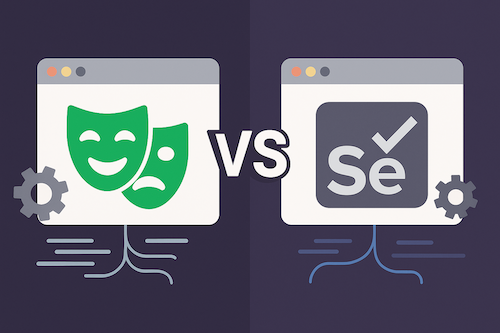
Table of Contents
Ensuring the reliability and functionality of web applications is a non-negotiable aspect of modern enterprise IT. These applications grow more complex by the day, and with that complexity comes the challenge of effective testing. Automated web UI testing has long been a cornerstone of quality assurance strategies, with Selenium dominating the landscape for years. However, newer contenders like Playwright are making significant inroads, forcing enterprises to reconsider their automation strategies.
The core challenge in web UI automation isn’t new: applications are dynamic, user interfaces evolve constantly, and cross-browser consistency remains a persistent hurdle. Teams require tools that aren’t just robust but also adaptable and efficient. For many years, Selenium, with its WebDriver protocol, has been the default answer. But is it still the best one?
Selenium: The Established Standard-Bearer
Selenium’s longevity speaks to its foundational strengths. It boasts unparalleled language support (Java, C#, Python, Ruby, JavaScript, and more) plus compatibility with virtually every browser imaginable. This extensive ecosystem and massive community translate to readily available resources, integrations, and a large talent pool. Insights distilled from numerous complex system deployments indicate that for many organizations, Selenium has been (and continues to be) a reliable workhorse, particularly where deep-rooted testing frameworks already exist.
Yet, a perspective forged through years of navigating real-world enterprise integrations suggests that Selenium’s age sometimes shows. Its API, while comprehensive, can feel cumbersome when dealing with certain modern web constructs. Handling dynamic elements, iframes, or shadow DOMs is certainly possible, but often requires intricate workarounds that can slow development and increase maintenance overhead.
Test execution speed has also been a recurring point of contention. While not necessarily a deal-breaker, it’s something teams notice when they’re running extensive test suites multiple times daily.
Playwright: The Modern Challenger
Enter Playwright, Microsoft’s newer entrant that seems purpose-built to address many of these modern challenges. Its architecture prioritizes speed and reliability from the ground up. One of its most celebrated features is auto-wait capability, which intelligently waits for elements to be actionable. This reduces test flakiness, which is a common pain point I’ve observed across many test automation initiatives.
Playwright’s API feels more aligned with contemporary web development practices. It offers more straightforward ways to interact with complex UI elements, including superior Shadow DOM and iframe handling. The tool also brings powerful features like network interception, device emulation, and built-in video recording of test executions. Supporting Chromium, Firefox, and WebKit with a unified API across multiple languages (JavaScript/TypeScript, Python, Java, C#) gives it broad appeal without sacrificing functionality.
What’s particularly interesting is how Playwright handles modern web application patterns. Single-page applications, progressive web apps, and heavily JavaScript-dependent interfaces are all areas where traditional automation tools sometimes struggle, yet they seem to be natural territory for Playwright.
Strategic Considerations for Enterprise Adoption
Does this mean enterprises should immediately shift from Selenium to Playwright? Not necessarily. The decision is, predictably, more nuanced than that.
Existing Investments & Skillsets represent a significant factor. Organizations with substantial investments in Selenium-based frameworks and skilled Selenium teams will understandably be cautious about complete overhauls. The cost and effort of migration can’t be understated, particularly when existing frameworks are functioning adequately.
Project Needs & Modernity often tip the scales. For new projects, especially those leveraging cutting-edge web technologies or requiring very fast feedback loops, Playwright presents a compelling case. Its handling of modern web features is frequently cited as a significant advantage by teams working with contemporary application architectures.
Ecosystem and Maturity considerations remain important. While Playwright’s community is growing rapidly, Selenium’s vast ecosystem and decades-long maturity mean more third-party integrations and a larger historical knowledge base. This can be crucial for complex enterprise environments with unique integration requirements or specialized testing needs.
Longitudinal data and field-tested perspectives highlight that the choice often boils down to a trade-off between leveraging existing, mature frameworks versus adopting newer tools that might offer efficiencies for specific types of modern development. Some teams are exploring hybrid approaches by using Playwright for newer modules or specific test types while maintaining Selenium for legacy suites. This strategy allows organizations to gradually evaluate Playwright’s benefits without disrupting established processes.
Making the Strategic Choice
The landscape of web automation continues evolving at a rapid pace. Both Selenium and Playwright are powerful tools, and the “best” choice often depends on an enterprise’s specific context, existing infrastructure, team skills, and strategic technology direction.
For organizations heavily invested in Selenium with well-functioning frameworks, the case for immediate migration may be weak. However, for teams starting fresh or struggling with modern web application testing challenges, Playwright deserves serious consideration. The tool’s modern architecture and developer-friendly features can significantly impact productivity and test reliability.
This conversation becomes increasingly important as the demand for faster, more reliable software delivery intensifies across enterprises. The choice between these tools isn’t just about technical capabilities but rather about aligning automation strategy with broader digital transformation goals.
What’s your perspective on the Playwright versus Selenium discussion for enterprise web automation? I’d be interested to hear your thoughts and experiences on LinkedIn.